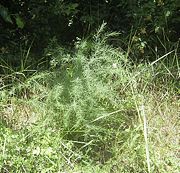
Asparagus is a type of vegetable obtained from one species within the genus Asparagus, specifically the young shoots of Asparagus officinalis. It has been used from very early times as a culinary vegetable, owing to its delicate flavour and diuretic properties. There is a recipe for cooking asparagus in the oldest surviving book of recipes, Apicius's 3rd century CE De re coquinaria, Book III.

Steamed Asparagus prepared with roasted pine nuts.

In their simplest form, the shoots are boiled or steamed until tender
and served with a light sauce like hollandaise or melted butter or a
drizzle of olive oil with a dusting of Parmesan cheese. A refinement is
to tie the shoots into sheaves and stand them so that the lower part of
the stalks are boiled, while the more tender heads are steamed. Tall
cylindrical asparagus cooking pots have liners with handles and
perforated bases to make this process foolproof.
Unlike most vegetables, where the smaller and thinner are the more
tender, thick asparagus stalks have more tender volume to the proportion
of skin. When asparagus have been too long in the market, the cut ends
will have dried and gone slightly concave. Meticulous cooks scrape
asparagus stalks with a vegetable peeler, stroking away from the head,
and refresh them in ice-cold water before steaming them; the peel is
often added back to the cooking water and removed only after the
asparagus is done, this is supposed to prevent diluting the flavor.
Small or full-sized stalks can be made into asparagus soup. Cantonese
restaurants in the United States often serve asparagus stir-fried with
chicken, shrimp, or beef. Asparagus may also be quickly grilled over
charcoal or hardwood embers, for an infusion of smoke flavor. Asparagus
is one of few foods which is considered acceptable to eat with the hands
in polite company, although this is more common in Europe
| < Prev | Next > |
|---|
















